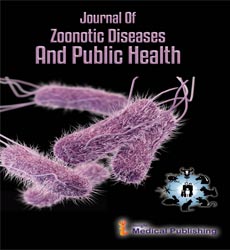General Introduction of Nipah Viral Infection
Ryan Currey*
Department of Public Health, Imperial College London, London, UK
- *Corresponding Author:
- Ryan Currey
Department of Public Health,
Imperial College London,
London,
UK,
E-mail: ryan.currey@rc.uk
Received Date: December 03, 2021; Accepted Date: December 17, 2021; Published Date: December 24, 2021
Citation: Currey R (2021) General Introduction of Nipah Viral Infection. J Zoonotic Dis Public Health. Vol.5 No.S2:e003.
Description
Nipah virus was first emerged in Malaysia in 1998 and was isolated and identified by a team of researchers at the Faculty of Medicine, University of Malaya in 1999. It causes a viral infection called Nipah virus infection and the disease is named after a village in Malaysia, Sungai Nipah. A mild respiratory and neurological disease in swine was initially caused by the virus and thereafter an acute and frequently fatal febrile encephalitic disease occurs in humans. Initially, the disease outbreak was attributed to Japanese encephalitis virus, but laboratory analysis subsequently lead to the identification of a novel paramyxovirus related to Henipavirus.
The Nipah virus is a type of RNA virus which belongs to the family of Henipavirus. The virus generally spread among some fruit bats. This virus can be transmitted from human-to-human and from animals to human. The virus is transmitted from human- to-human, when there is a close contact with NiVinfected persons or exposure to NiV-infected body fluids like urine, blood and nasal secretions. Animal to human transmission typically requires direct contact with an infected source and exposure to contaminated secretions or tissues of infected bats or pigs.
Nipah virus infection has non-specific symptoms and will start to appear five to fourteen days after exposure. The intial symptoms include fever, cough, headache, difficulty in breathing, and confusion. As the disease advances, neurological symptoms become the more important feature and, depending on the strain, respiratory involvement to various degrees. Respiratory involvement has been a more predominant feature of NiV infection in Bangladesh and India, after recovery complications like inflammation of the brain and seizures will occur.
In Malaysia the human infections were almost all associated with contact with infected pigs. In order to stop the spread of disease millions of infected pigs were killed by Malaysian authorities in 1999 and proved this as a successful measure of prevention of this disease. The disease has been spread by consuming raw date palm sap (toddy), using water from wells inhabited by bats and eating of fruits partially consumed by bats.
Preventive measures include not drinking raw date palm sap, avoiding exposure to bats and sick pigs and Diagnosis is based on symptoms and confirmed by laboratory testing. Nipah patients aged above 45 and having breathing difficulty are more likely to transmit the virus, than those without respiratory illness.
Hospital workers and caretakers of the virus infected persons will have the maximum risk of exposure. Standard infection control practices and proper barrier nursing techniques are recommended to avoid the spread of the infection from person to person and can protect against human-to-human hospital acquired infections. There is no specific treatment for Nipah virus infection and therefore suspected cases of Nipah virus infection should be isolated and supportive care is provided to overcome the infection. Outbreaks can be reduced by surveillance and awareness.
There is neither vaccine nor specific treatment for this infection. To produce cross-protective antibodies against both henipavirus and nipahvirus a subunit vaccine using the Hendra G protein was found and this has been used in monkeys to protect against Hendra virus but its capability for use in humans has not been studied.
Open Access Journals
- Aquaculture & Veterinary Science
- Chemistry & Chemical Sciences
- Clinical Sciences
- Engineering
- General Science
- Genetics & Molecular Biology
- Health Care & Nursing
- Immunology & Microbiology
- Materials Science
- Mathematics & Physics
- Medical Sciences
- Neurology & Psychiatry
- Oncology & Cancer Science
- Pharmaceutical Sciences
